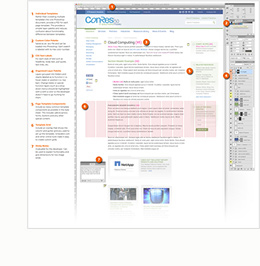Last week, Mark and I had the pleasure of speaking at Valuable Content‘s Bristol Content Group event — virtually! Thanks to the technical wizardry of Sonja and Matt from Desynit, we spoke to a packed crowd in Bristol, UK, from the comfort of our Chapel Hill offices. After reading our article last fall on why We Don’t Build Websites Anymore, Sonja was eager to find a way to present this material to her community and put together the event in pretty short order. Mark and I spent an hour presenting on the lead development ecosystem and the future of web development and then took questions from the crowd. It was a great event, and hopefully a step toward an in-person event in the UK sometime soon. Below is a transcript of my portion of the material. (Sonja posted a full recap via Storify.)

Thanks, Mark.
Hi, everyone. My name is Chris. I’m the COO of Newfangled. But you know, my background is in design. I studied at the Rhode Island School of Design, which is an art and design college here in the states. I’ve had a few years to reflect upon that education and I’ve concluded that one of the most important things I learned there is that seeing is not at all straightforward.
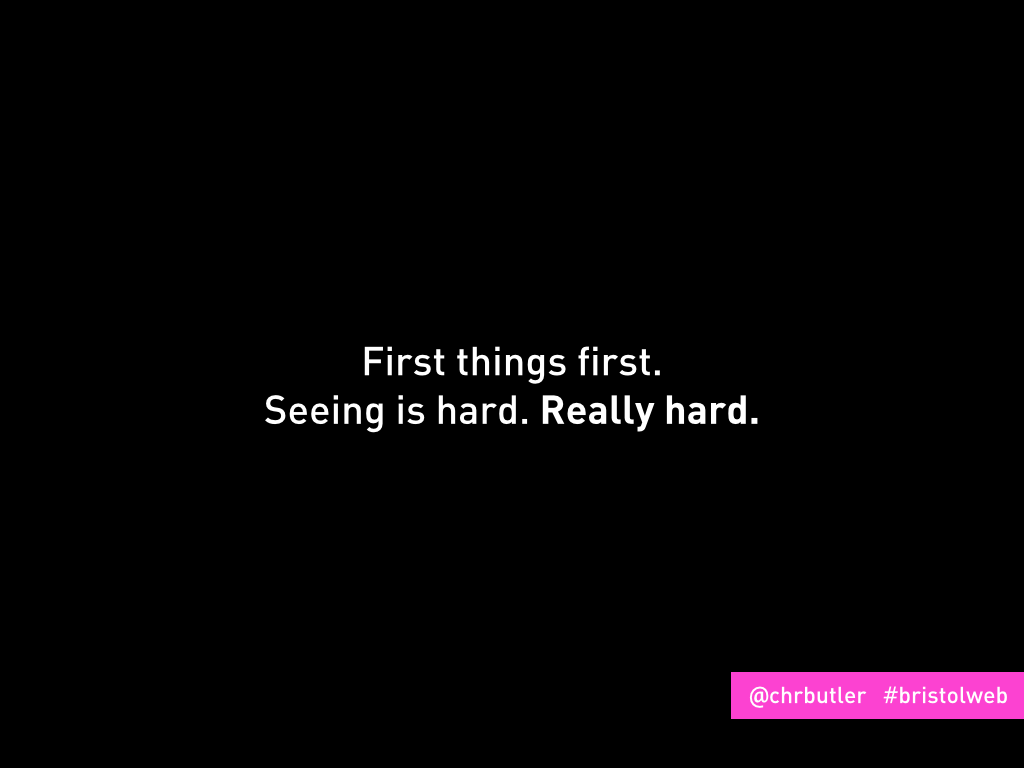
In my first drawing courses, I learned that you had to spend some time quite close to the surface on which you were working — where you could see the finer details — as well as at a distance from it — where you could see, as is often said, the “big picture.” It really didn’t matter what medium you were working with; this principle always applied. Even working with film and video, which became my concentration there, you had to pay just as much attention to the split second transitions between images as you did the story that those images created. There is always detail, and there is always a big picture.
As for detail, your brains must be close to saturated at this point already. The ecosystem that Mark described is a very detailed one, isn’t it? The fact that it is so detailed — that we have to be concerned with the minutia of lead development — how our contacts engage with our content — speaks to a big picture that we must also be concerned with. It’s not just that digital marketing is becoming more complex. It’s not just that the technology available to us is becoming more sophisticated. Both of these things are true, of course, but something bigger is going on. You and I sit in the eye of an information storm that churns around us far too quickly to be fully understood from within it. If we can get outside of it, if we can step back enough to consider the information around us in a new way, I think we’ll see a bigger picture that we might find surprising.
There are two major trends that will change everything.
The first one has to do with programming.
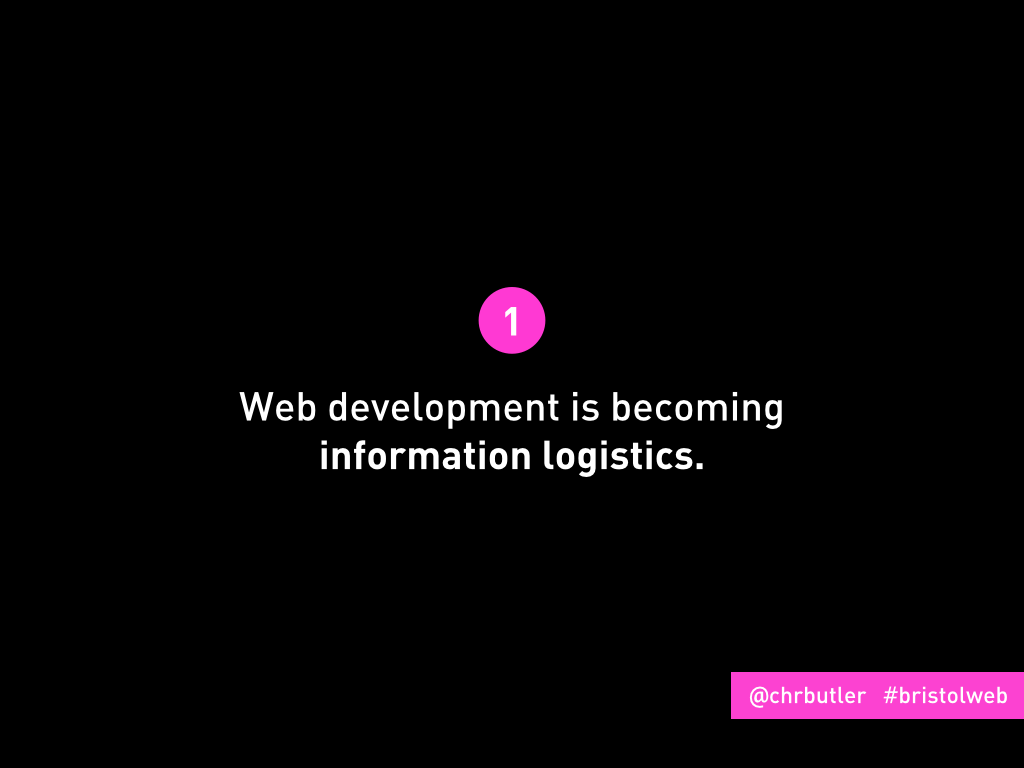
TREND 1. web development is becoming information logistics
The history of programming is a story of abstraction. In fact, abstraction is a principle for programmers. It essentially means, never duplicate information if you don’t have to. This principle has guided the evolution of programming from the matrix-style zeroes and ones to the systems we have today, which offer much more complexity while being much simpler to express. So, we’ve gone from having to rewrite the rules of language, speech and customs every time we wanted to say “hello” to just being able to say hello.
Programmers are farther away today from the “guts” of code than they’ve ever been, and while that may seem scary in some ways, we mostly don’t think about it because we’re really just trying to make boxes of text and images appear on screens.
This is programming. It’s one layer stacked upon another. PHP, for example, which is the programming language on which many content management systems, like ours and WordPress, are based, is a layer of programming with its own syntax — or ways of expressing objects and commands — that sits on top of another language environment — in this case an operating system called Linux — which sits on top of another language environment called C.
So here’s why this matters.
Mostly, we think of websites as closed systems. You set up a server, install an operating system on it, then install PHP in that OS, and THEN start building your site.
But, websites do so much more than just communicate with themselves, right? They sit right there at the center of the ecosystem that Mark just finished describing. They have become platforms responsible for exchange and processing of information.
In order to do that, they have to understand how to get their information into outside systems and back again, AND they have to understand how to get information from outside systems into their system and back again. It’s like technological diplomacy: different customs, different languages.
This is why we have APIs. Application programming interfaces abstract that diplomacy so that you can plan for routine exchanges of information in advance. An API can be as simple as embedding a youtube video, or as complex as reconciling inventory among all the parties that sell things. In any case, the API is making an information transaction possible. Embedding a video is really just another way of saying, “hey database, show me that video,” the other database saying, “oh, this video?” your database saying, “yes, that’s the one!” the API saying, “ok, here it comes,” then getting that video sent over and matched to a player sitting in the right place on the page. An API makes this whole conversation happen relatively instantaneously and the same way every time.
Now think of most of the websites you use today. How many of the things you see — whether images, text, or some other media — are appearing there as a result of an API? Almost all of them. The programming isn’t creating these things from scratch. It’s making it possible for them to be there and for you to interact with them.
So now we see a different picture. We went from what web development looked like fifteen years ago — solitary acts of programming closed systems — to what it looks like today: complex, collaborative, information logistics.
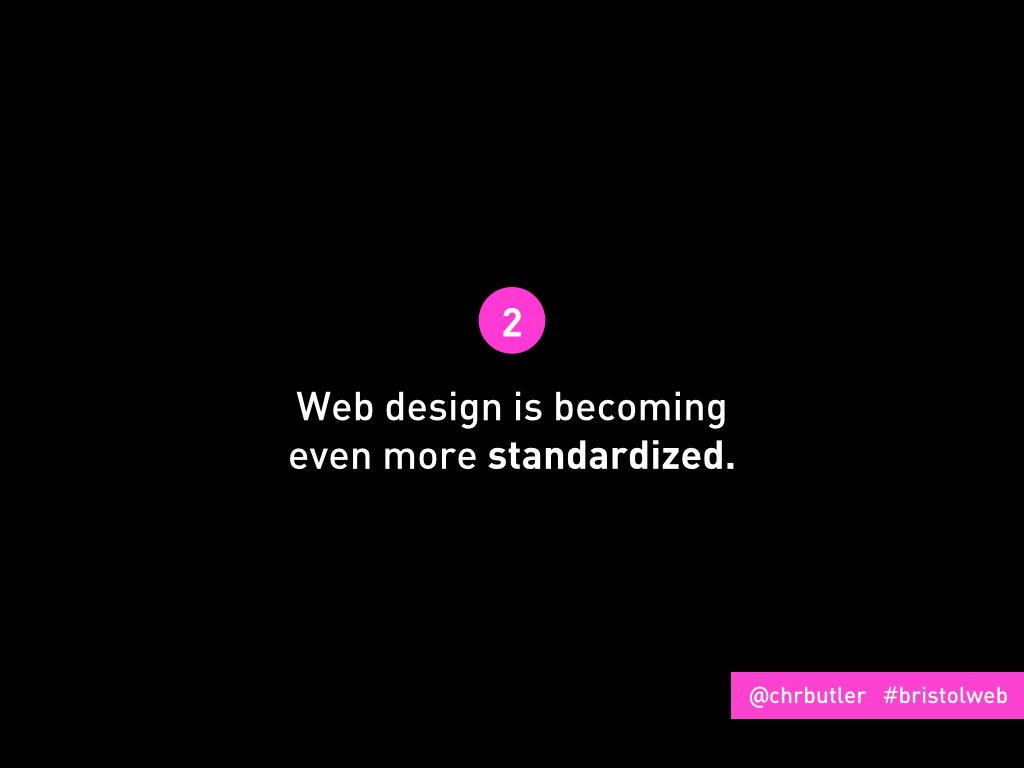
TREND 2. web design is becoming even more standardized
The form of web information — the way websites look — has gone through several cycles of upheaval since web design became a profession. Tracing that is, essentially, tracing the process of figuring out both what the web can do and how we want to use it.
But, that means that the ups and downs of all of that will settle down.
See, there ARE conventions — things like predictable kinds of information, predictable places information is located, predictable ways it is displayed, etc. Conventions exist because predictability is a critical part of interacting with information successfully.
Within the rectangle, there are only so many options worth playing with that are actually useful. You can get as creative as you want, of course, provide you’re OK with some people being confused or too impatient to figure out what to do.
But design conventions aren’t just restrictions the web is imposing upon us. They exist everywhere.
The same thing happened with books, which, after all, are just another form information can take. Within their rectangles, there are also predictable kinds of information, predictable places that information is located, and predictable ways it is displayed. Tables of contents, for example, are a convention. Same thing with where we tend to locate author bylines, chapter headings, or page numbers. These are the information architecture of books, and they are quite standardized.
And there doesn’t tend to be much unnecessary decor within books. Most books are pretty utilitarian.
Now, I’m not trying to build a case for websites ultimately being stripped down to just columns of text. Nor am I saying that all websites will or should look the same. To the contrary, as a visual person, I of course believe that there’s value in pushing the form. That’s been true of paper media and it’s true for screen media, too. But form-pushing will always be in the minority and it will always tend toward application in areas which can withstand it the most. See, as a creative person, I want to play with the covers of things, the typography, the images, but as a designer and a writer, I’m NOT that interested in re-teaching my audience how to read. That sentiment is where standardization comes from.
For years, the WC3 was pushing for standardization — for how we lay out pages, how we deal with typography, etc. It never really gelled in the way it should have. That’s for a variety of reasons, not least of which is that we hadn’t gotten the novelty of the web out of ours systems yet. But now, we rely upon it so greatly that stability and reliability always outweigh novelty.
And now, things like the Twitter bootstrap is bringing standardization even closer to a reality because it offers greater functionality to designers and developers as well as consistency. It offers tools to ensure that the way we do basic informational things — showing and hiding, listing, sorting, etc. — happens in a way that looks familiar to people. Consistency is clearly something designers have been willing prioritize over novelty. Thank goodness.
In fact, most of what we think of when we think of websites — all the pretty wizbang stuff, like responsive grids, transitional animations, slideshows, expanding and contracting layers, tabbed interfaces, sticky elements — all that stuff, even typography! is becoming pretty plug and play. Well, to be fair, plug, play and debug. But even so, you’re not writing this stuff from scratch. You find the element you need in a library, you use its API, and you’re off and running!
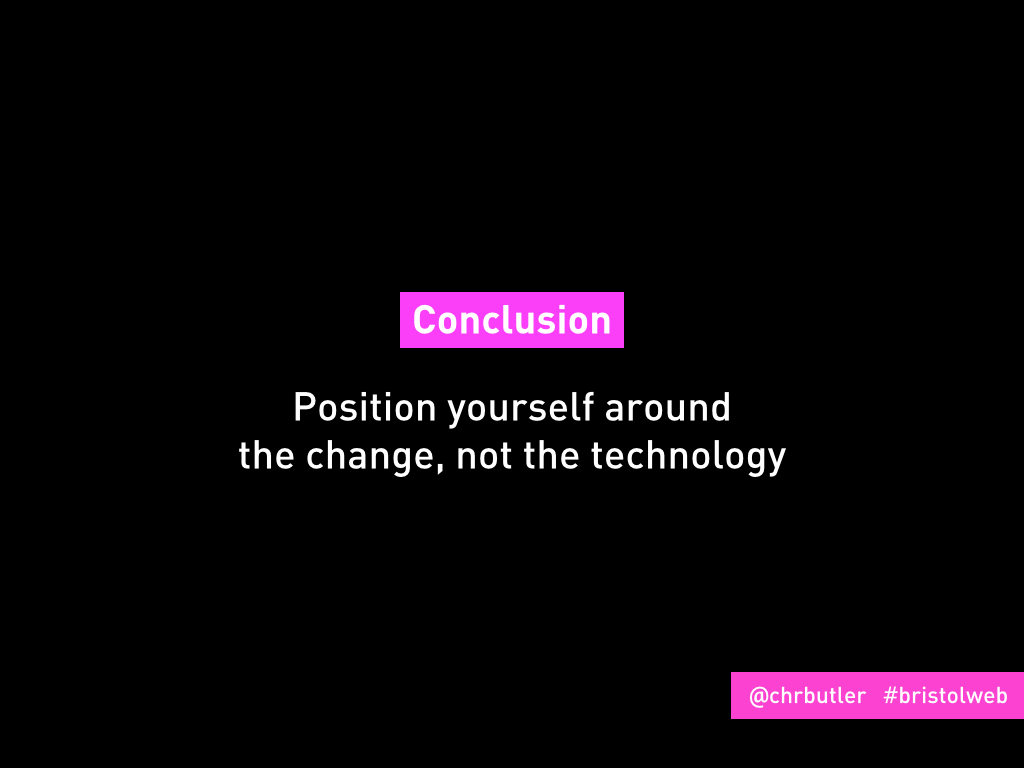
So, what does this all mean?
Well, the most important thing to consider strategically is this: The ecosystem is growing in platform complexity, but stabilizing in terms of display methodology.
A radical shift in markup techniques is far less likely than the creation of a disruptive new platform that does something new with existing information. That means that the value of front-end web development is dropping, while the value of all the unseen stuff — the information logistics — is rapidly increasing.
So this is where you need to focus and position yourself, otherwise you’ll be underbid by someone who can do it cheaper or rendered obsolete by some system that makes it all just work with one click.
Position yourself around the change itself. When your expertise is in connecting platforms, a new one is opportunity knocking, not slamming the door in your face!
It’s about strategy not tactics, or as we’ve enjoyed saying lately, platforms, not programs!
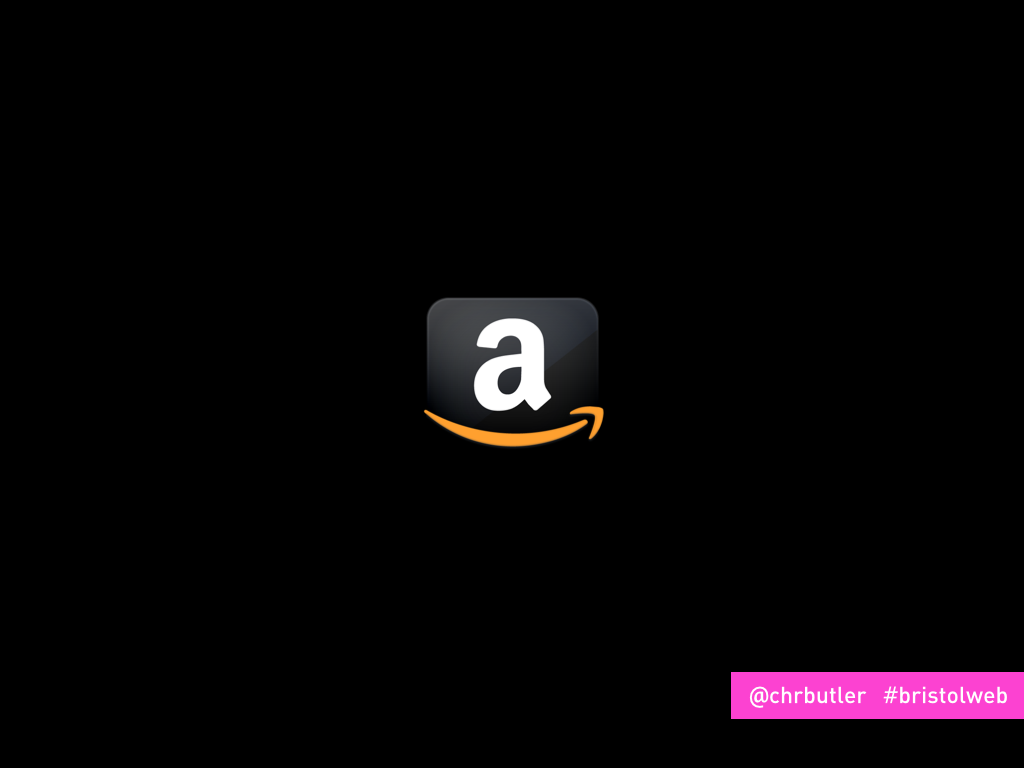
OK, an example might help to really solidify this in our minds. So here’s one.
Amazon.
What Salesforce is doing for sales and marketing, Amazon is doing for e-commerce. Specifically what I have in mind here is major MAJOR consolidation.
If you’re committed to other e-commerce services like Paypal, Intuit, Shopify, or even Magento, know that each of them will probably eventually be overtaken by Amazon. Amazon will either seduce their existing customers away or just buy these companies outright. Just to clear the field.
Now, Amazon’s current e-commerce offerings aren’t great. They’ve got installable storefront systems and some payment processing. Most solutions do one or the other really well, but not both. And this makes sense — the more sophisticated your e-commerce operation is logistically, the less likely it is to be able to make use of a system out of the box. It will need really solid processing and something custom architecturally. On the other hand, a simple store — say with one item or two — could use something really basic, but then might run into trouble with limited processing options. It’s a bit of a goldilocks problem. And right now, the e-commerce world is fractured because nobody has been able to offer something “just right.” Amazon will.
Why? Well, today, e-commerce still only represents a single percentage point of overall “offline” commerce. A single percentage point! Still! That means there is an enormous amount of opportunity.
Now, the closest thing Amazon has to a turnkey system is called Amazon Webstore. It’s great if you’re willing to divide your marketing and sales efforts — because it’s a hosted application that is customized for e-commerce architectures, but not for all the other kinds of content you know you need to create. It’s not a CMS. You can’t add products AND blog posts, or whitepapers, or webinars, or whatever. You can sell things, but you can’t do content marketing there. Well, that’s contrary to our entire point of view, isn’t it? We’ve been saying this whole time that your ecosystem is one that closes the loop — technologically — between marketing and sales.
But Amazon has a lot of customers on this platform. Customers who are willing to silo these things. For now. In five years, they’ll be over that. Amazon isn’t dumb. They know this. So meanwhile, Amazon is using this time to do research and development — through this partial system.
In parallel, Amazon is playing with two things: Fullfilment and AI. On the fulfillment side, they’re offering all kinds of programs for retailers to partially offload their inventory management to Amazon and for customers to customize delivery of their stuff. This is all research and development to figure out how these logistics work.
The second thing is this other system called Mechanical Turk. Basically, this is a system that allows you to offload menial tasks — busywork — to people all across the globe through an online interface. Amazon takes a cut of whatever you pay them. But obviously they’re not in it for that pocket change. This is a laboratory. They want to analyze these productivity tasks and use them for AI models. Eventually, they’ll cut out the people at the other end of the line.
Put these two things together and you’ve got a complete system: Inventory management, storefront, payment processing, and fulfillment.
This is possible because they’ve got their eye on the system of information logistics, not a discrete technology. It’s a platform strategy, not a program strategy.
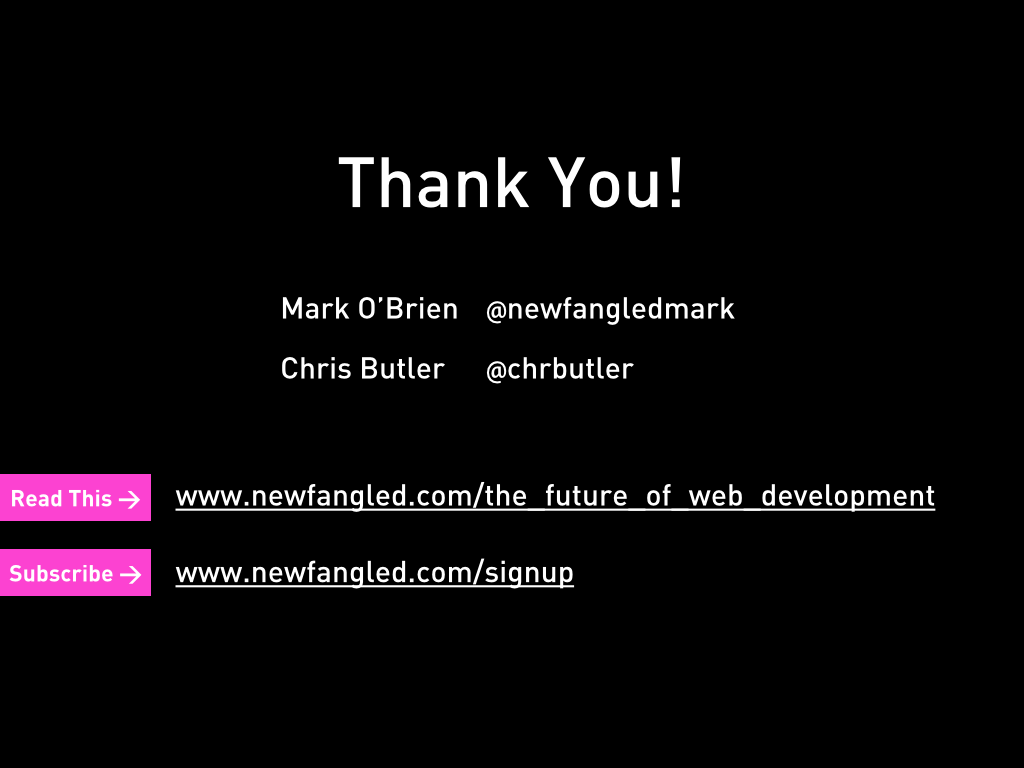
We’ve got to do likewise.
The lead development ecosystem exists today, just as Mark described it. Now you know about it and can plan accordingly.
But it is a manifestation of these converging trends: abstraction, information logistics, and standardization of form. The convergence point of these trends is the commoditization of what used to be the primary good for sale in web development — playing with HTML and CSS. It’s a major threat to many people working today in the digital marketing space.
The good news is, this isn’t going to put people out of work over night. But you need to act on this now.
Today we have more developers on staff than we ever have. But they’re not spending most of their time making templates and style sheets. They’re spending most of it brokering the flow of information from one system to another through the platforms we build.
That’s what we mean when we say we don’t build websites anymore. We build marketing platforms. That’s your future.

